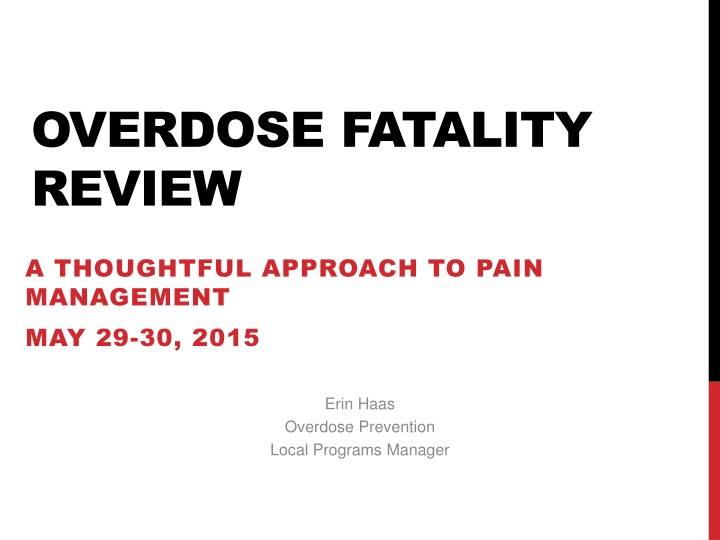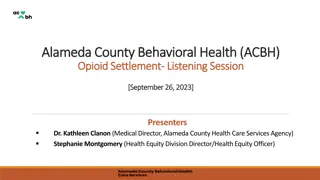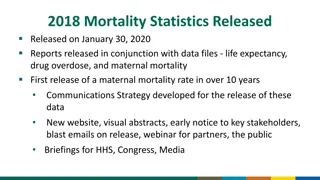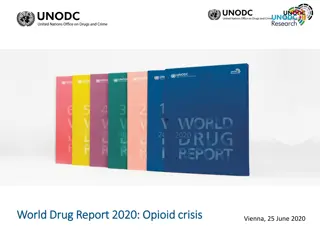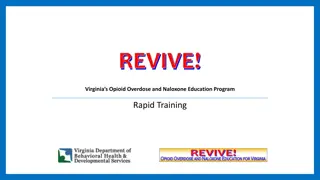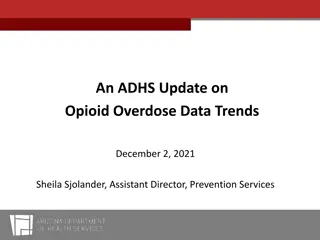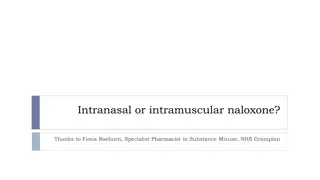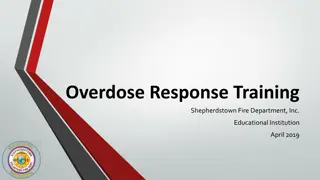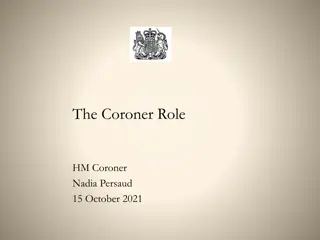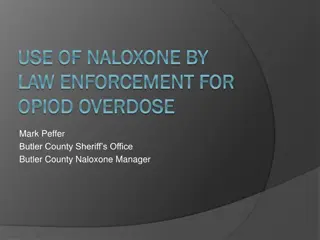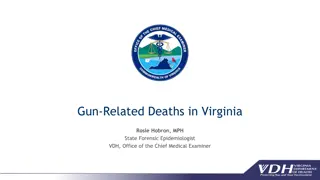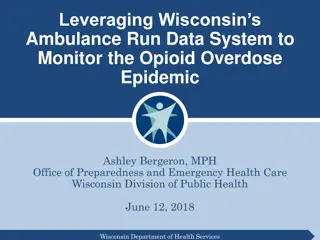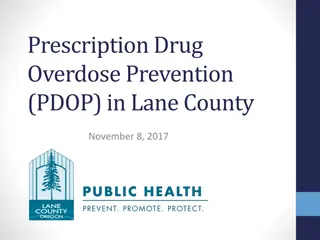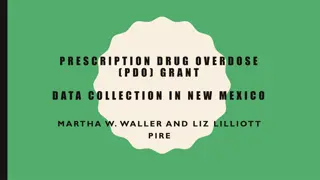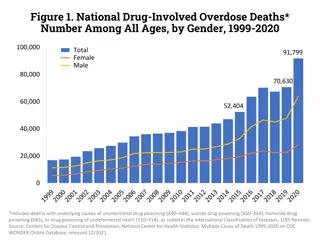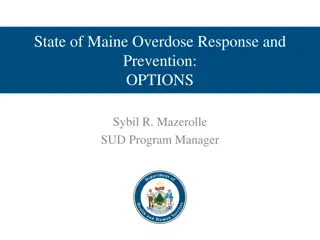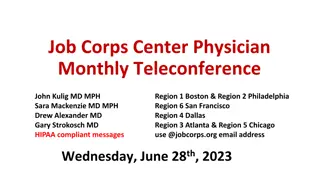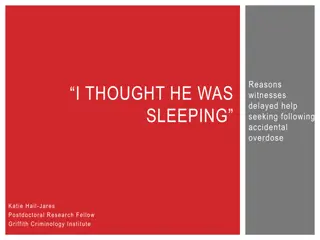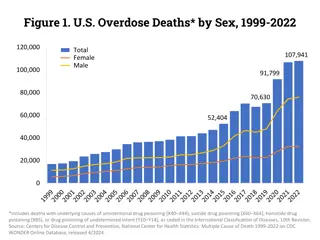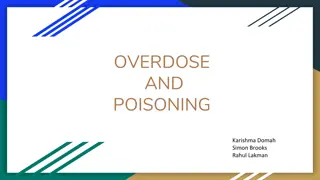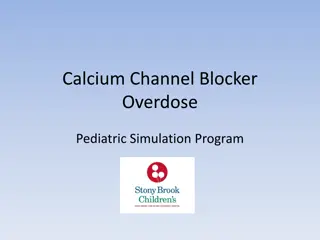Overdose Fatality Review - Preventing Future Deaths
Modeled after mortality review teams, the Overdose Fatality Review aims to identify prevention opportunities, build stakeholder relationships, recommend strategies, and provide legal authority. Through open communication and data collection/reporting, the teams review cases and generate ideas to address overdose fatalities effectively.
Download Presentation

Please find below an Image/Link to download the presentation.
The content on the website is provided AS IS for your information and personal use only. It may not be sold, licensed, or shared on other websites without obtaining consent from the author.If you encounter any issues during the download, it is possible that the publisher has removed the file from their server.
You are allowed to download the files provided on this website for personal or commercial use, subject to the condition that they are used lawfully. All files are the property of their respective owners.
The content on the website is provided AS IS for your information and personal use only. It may not be sold, licensed, or shared on other websites without obtaining consent from the author.
E N D
Presentation Transcript
OVERDOSE FATALITY REVIEW A THOUGHTFUL APPROACH TO PAIN MANAGEMENT MAY 29-30, 2015 Erin Haas Overdose Prevention Local Programs Manager
OVERDOSE FATALITY REVIEW Modeled after other mortality review teams (CFR, FIMR, etc.) Multi-agency/multi-disciplinary team assembled to conduct confidential case reviews of overdose deaths Goal to prevent future deaths by Identifying missed opportunities for prevention and gaps in system Building working relationships b/t local stakeholders on OD prevention Recommending policies, programs, laws, etc. to prevent OD deaths Informing local overdose prevention strategy Department of Health and Mental Hygiene (DHMH) provides TA & death records to teams Team members bring info from respective agencies about decedents to inform review 3 Pilot Teams Baltimore City, Cecil County, Wicomico County
OVERDOSE FATALITY REVIEW Legal authority Pilot phase: medical review committees HB1282 passed and went into effect 10/1/14 OFR law (HB1282) gives structure and authority to the teams (membership, goals, etc.) provides civil liability protection for team members and those that provide information to the teams establishes confidentiality requirements establishes expectations and reporting requirement to DHMH TA continues to new and existing teams 11 new teams have begun reviewing cases Attending all first meetings Bimonthly conference calls
The open communication will help resolve the barriers that we face in the community The meetings were stilted at first, but have been improving- nearly all members contribute to discussions, which are often lively, and we spend enough time on cases to generate ideas Its definitely helping us get to the story behind the numbers
OPERATIONS Three pilot teams Mental Health Treatment Social Services Community Supervision State's Attorney SEP/Staying Alive Pharmacy Drug Treatment (Public and Private) Hospital Board of Education Dept. Juvenile Services Cecil, Wicomico, Baltimore City Met at least quarterly, reviewed 86 cases from January October 2014 Agencies involved: EMS Sheriff's Office Detention Center Court System
DATA COLLECTION/REPORTING Meetings Demographics Date of death Cause of death Indication of data reviewed Key observations Trends, potential recommendations at policy, system and program level Data challenges Recommendation tracking Updated quarterly Reported to DHMH
CASES REVIEWED Total: 86 Pilot Phase: January October 2014 Unkno wn <18 18-24 25-34 35-44 45-54 55-64 65+ Total Gender Male 0 5 15 12 16 11 3 0 62 72% Female 0 1 8 5 5 3 1 1 24 28% Race/Ethnicity African American Hispanic White Unknown 0 0 0 0 2 0 4 0 5 1 16 1 3 0 13 1 7 1 13 0 5 0 9 0 1 0 2 1 0 0 1 0 23 2 58 3
AGENCY INTERACTION 1 56 76 11 8 22 31 25 29 10 4 49 9 1 VA 65% 88% 13% 9% 26% 36% 29% 34% 12% 5% 57% 10% EMS Law Enforcement Detention Center Court System Mental Health Tx Social Services Community Supervision State's Attorney SEP/Staying Alive Pharmacy Drug Tx (Public and Private) Hospital
AGENCY INTERACTION Unknow n Total Inter. <18 18-24 25-34 35-44 45-54 55-64 65+ 0.00% 0.00% 1.22% 4.88% 2.13% 7.32% 0.30% 0.00% 0.00% 0.00% 0.00% 0.00% 1 VA 0.00% 3.05% 4.27% 2.74% 0.61% 0.30% 56 EMS 0.00% 4.27% 5.18% 3.66% 0.91% 0.30% 78 Law Enforcement 0.00% 0.30% 0.91% 0.61% 0.91% 0.30% 0.30% 0.00% 11 Detention Center 0.00% 0.30% 0.61% 2.13% 0.61% 2.44%2.44% 0.91% 0.30% 0.61% 0.30% 0.00% 0.00% 8 Court System 0.00% 1.22% 1.52% 0.91% 0.30% 0.00% 22 Mental Health Tx 0.00% 0.91% 1.22% 0.30% 0.00% 26 Social & Human Services 0.00% 0.00% 1.83% 1.52% 2.13% 1.52% 0.30% 0.30% 25 Community Supervision 2.44% 2.44% 0.00% 0.00% 1.83% 1.52% 0.61% 0.00% 29 State's Attorney 0.00% 0.00% 0.61% 0.61% 1.22% 0.30% 0.30% 0.00% 10 SEP/Staying Alive 0.00% 0.30% 0.00% 0.30% 0.00% 4.27% 0.30% 0.30% 0.00% 4 Pharmacy 0.00% 0.61% 3.66% 3.35% 1.52% 0.91% 0.61% 49 Drug Tx (Public and Private) 0.00% 0.30% 0.91% 0.30% 0.61% 0.00% 0.61% 0.00% 9 Hospital 328
AGENCY INTERACTION Unknow n 0.00% Total Inter. 100.00% <18 0.00% 18-24 0.00% 25-34 100.00% 35-44 0.00% 45-54 0.00% 55-64 0.00% 65+ 0.00% VA 7.14% 28.57% 0.00% 17.86% 25.00% 16.07% 3.57% 1.79% 100.00% EMS 8.97% 30.77% 9.09% 0.00% 0.00% 17.95% 18.18% 21.79% 27.27% 15.38% 9.09% 3.85% 9.09% 1.28% 0.00% 100.00% 100.00% Law Enforcement Detention Center 27.27% 12.50% 37.50% 0.00% 12.50% 25.00% 12.50% 0.00% 0.00% 100.00% Court System 9.09% 31.82% 0.00% 18.18% 22.73% 13.64% 4.55% 0.00% 100.00% Mental Health Tx 7.69% 30.77%30.77% 0.00% 11.54% 15.38% 3.85% 0.00% 100.00% Social & Human Services 20.00% 28.00% 20.69% 24.00% 27.59% 0.00% 0.00% 0.00% 0.00% 20.00% 17.24% 4.00% 6.90% 4.00% 0.00% 100.00% 100.00% Community Supervision State's Attorney 27.59% 20.00% 40.00% 25.00% 0.00% 0.00% 0.00% 25.00% 20.00% 0.00% 10.00% 25.00% 10.00% 25.00% 0.00% 0.00% 100.00% 100.00% SEP/Staying Alive Pharmacy 0.00% 22.45% 28.57% 24.49% 0.00% 4.08% 10.20% 6.12% 4.08% 100.00% Drug Tx (Public and Private) 11.11% 33.33% 0.00% 11.11% 22.22% 0.00% 22.22% 0.00% 100.00% Hospital
DATA CHALLENGES AND LIMITATIONS Dependent on entity, agency, or organization s record keeping system and member attendance Time span of records Detail of medical history Veteran status/VA data Prescription data or PDMP Treatment data post-SMART Juvenile records Out of state records
NOTABLE TEAM MEMBER OBSERVATIONS Sheer amount of interaction with systems Especially the criminal justice system in BC Role of alcohol in overdose deaths Older drug users are at risk, with many co-occurring chronic health issues Care coordination in somatic health and after substance use disorder treatment Occurrence of trauma just before death (loss of a loved one, struggles with child custody, etc.)
TRENDS Deaths occurring in hotels and motels Recent release from jail; detoxification in jail system before release Hispanic population and LGBT History of intimate partner violence Poly-pharmacy Previous overdose Pain management noted in 7/86 (8%) pilot cases
IMPACTS/OUTCOMES ON PARTICIPATING AGENCIES Increase in number and improved the quality of the referral system Training of staff to use naloxone Educated and increased the awareness of staff of overdose related issues Promoting substance use disorder education and assessment at all levels of the organization Broader understanding of overdose in the community More direct outreach to families on overdose prevention and wraparound services by those that serve people at risk of overdose Changes to intake questionnaires to include questions about overdose history
OUTCOMES SYSTEM LEVEL Collaboration among partner agencies to strengthen outreach: BHSB and EMS Improvement to Treatment Referral Line in Baltimore City, collaboration between HCAM and BHSB Collaboration between local health department and EMS to follow up with overdose survivors Changes proposed to PDMP law to allow for data sharing with review teams
MOVING FORWARD Continue the momentum with existing teams to build upon observations and potential recommendations Capacity building of teams Conference calls/collaborative learning for coordinators Build team membership; improve attendence Continue support and technical assistance to new teams, ensure understanding of program goals and confidentiality Turn observations and recommendations into bigger action steps, further tracking those developments
CONTACT INFORMATION Erin Haas, MPH Maryland Department of Health and Mental Hygiene Behavioral Health Administration Overdose Prevention Office erin.haas@maryland.gov Office: 410-402-8574 Cell: 443-827-0735
